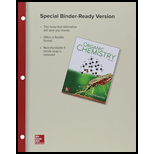
Concept explainers
(a)
Interpretation: The carbon radical formed by the homolysis of each type of
Concept introduction: The formation of carbocation, carbanion and free radical occur due to the heterolysis or homolysis process. Homolysis is opposite to the heterolysis. It forms radical with an unpaired electron. Heterolysis is a process in which unequal sharing of electrons results in breaking of the bond.
Carbocation behaves as electrophile due to lack of electrons and incomplete octet, whereas carbanion behaves as a nucleophile in the
(b)
Interpretation: The stronger
Concept introduction: The energy which is released or absorbed in the chemical reactions is referred to as
(c)
Interpretation: More stable radical formed from propane is to be identified.
Concept introduction: The formation of carbocation, carbanion and free radical occur due to the heterolysis or homolysis process. Homolysis is opposite to the heterolysis. It forms radical with an unpaired electron. Heterolysis is the process, in which unequal sharing of electrons results in breaking of the bond.
Want to see the full answer?
Check out a sample textbook solution
Chapter 6 Solutions
Loose Leaf for Organic Chemistry
- For each rate equation, what effect does the indicated concentration change have on the overall rate of the reaction?[1] rate = k[CH3CH2Br][-OH]a. tripling the concentration of CH3CH2Br onlyb. tripling the concentration of -OH onlyc. tripling the concentration of both CH3CH2Br and -OH[2] rate = k[(CH3)3COH]a. doubling the concentration of (CH3)3COHb. increasing the concentration of (CH3)3COH by a factor of 10arrow_forwardWhat reaction would acetylene likely undergo if it were kept at 1500 °C for too long?9arrow_forwardWhat about the second step in the electrophilic addition of HCl to an alkene-the reaction of chloride ion with the carbocation intermediate? Is this step exergonic or endergonic? Does the transition state for this second step resemble the reactant (carbocation) or the product (alkyl chloride)? Make a rough diagram of what the transition state may look like?arrow_forward
- 2. In the bromination reactions, what is the function of CCl4? Why can it fulfil its role?3. Bromination proceeds by either free radical substitution or electrophillic addition. Based on Table 3, which mechanism is followed by alkanes? by alkenes? by alkynes?4. For which hydrocarbon type is light necessary for bromination to take place?arrow_forwardDraw eugenol as a line structure. The double bonds of the benzene ring are fairly unreactive unless you use special catalysts. But the double bond on the side group is reactive. Draw the mechanism of eugenol reacting with HBr to form the two possible carbocation intermediates. Put your intermediates into square brackets. Label each carbocation as a methyl carbon or 1°, 2°, or 3°. Then circle a more stable carbocation if one is more stable. Can you guess what the final product is?arrow_forwardIn an SN1 reaction, Nucleophile- What are the characteristics of a good nucleophile for SN1? How does a chemist tell a strong versus weak or bulky versus not bulky nucleophile? Solvent-What is the best type of solvent for this reaction? Define the terms please.arrow_forward
- Draw resonance forms to show how the BHA radical is stabilized by delocalization of the radical electron over other atoms in the molecule.arrow_forwardHow does this rearrangement lead to the product? Why aren't there two double bonds in the structure? The bond attached to the hydrogen on the top is moved, but what happens to the bond attached to the hydrogen on the bottom?arrow_forwardIn cells, vitamin C exists largely as its conjugate base X. X is an antioxidant because radicals formed in oxidation processes abstract the labeled H atom, forming a new radical that halts oxidation. Draw the structure of the radical formed by H abstraction, and explain why this H atom is most easily removed.arrow_forward
- Free radical halogenation is used to replace one or more hydrogens on an alkane with one or more halogens (either chlorine or bromine). It is a substitution reaction. A student performs a free radical bromination on 3-methyl-pentane (5.88 g) to create the desired product of 3-bromo-3-methyl-pentane. The product mix, which hopefully contains almost all 3-bromo-3-methyl-pentane, is cleaned up by passing it through a gas chromoatograph, which separates out the 3-bromo-3-methyl-pentane from any undesired products made during the reaction (undesired products are created frequently in free radical halogenation). The initial product mix weighed 9.45 g; the purified 3-bromo-3-methyl-pentane weighed 7.21 g. What is the student's percent recovery?arrow_forward2-Chloro-2-methylpropane reacts with water in three steps to yield 2- methyl-2-propanol. The first step is slower than the second, which in turn is much slower than the third. The reaction takes place slowly at room temperature, and the equilibrium constant is approximately 1. a. Give approximate values for ΔG and ΔG° that are consistent with the above information. b. Draw an energy diagram for the reaction, labeling all points of interest and making sure that the relative energy levels on the diagram are consistent with the informationarrow_forwardwhich would be expected to convert 1 mole of 4-methyl-1-pentyne into 2-methylpentane? Na, NH3(l) 2 moles H2, Pt 1 mole H2, Pt 2 moles of HCl H2, Lindlar’s catalystarrow_forward
 Organic Chemistry: A Guided InquiryChemistryISBN:9780618974122Author:Andrei StraumanisPublisher:Cengage Learning
Organic Chemistry: A Guided InquiryChemistryISBN:9780618974122Author:Andrei StraumanisPublisher:Cengage Learning Organic ChemistryChemistryISBN:9781305580350Author:William H. Brown, Brent L. Iverson, Eric Anslyn, Christopher S. FootePublisher:Cengage Learning
Organic ChemistryChemistryISBN:9781305580350Author:William H. Brown, Brent L. Iverson, Eric Anslyn, Christopher S. FootePublisher:Cengage Learning

